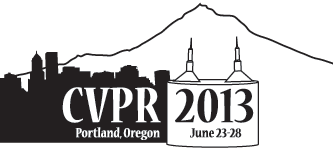-
Articulated and Restricted Motion Subspaces and Their Signatures
AbstractArticulated objects represent an important class of objects in our everyday environment. Automatic detection of the type of articulated or otherwise restricted motion and extraction of the corresponding motion parameters are therefore of high value, e.g. in order to augment an otherwise static 3D reconstruction with dynamic semantics, such as rotation axes and allowable translation directions for certain rigid parts or objects. Hence, in this paper, a novel theory to analyse relative transformations between two motion-restricted parts will be presented. The analysis is based on linear subspaces spanned by relative transformations. Moreover, a signature for relative transformations will be introduced which uniquely specifies the type of restricted motion encoded in these relative transformations. This theoretic framework enables the derivation of novel algebraic constraints, such as low-rank constraints for subsequent rotations around two fixed axes for example. Lastly, given the type of restricted motion as predicted by the signature, the paper shows how to extract all the motion parameters with matrix manipulations from linear algebra. Our theory is verified on several real data sets, such as a rotating blackboard or a wheel rolling on the floor amongst others.
Related Material
[pdf][bibtex]@InProceedings{Jacquet_2013_CVPR,
author = {Jacquet, Bastien and Angst, Roland and Pollefeys, Marc},
title = {Articulated and Restricted Motion Subspaces and Their Signatures},
booktitle = {Proceedings of the IEEE Conference on Computer Vision and Pattern Recognition (CVPR)},
month = {June},
year = {2013}
}
These CVPR 2013 papers are the Open Access versions, provided by the Computer Vision Foundation.
Except for the watermark, they are identical to the accepted versions; the final published version of the proceedings is available on IEEE Xplore.
Except for the watermark, they are identical to the accepted versions; the final published version of the proceedings is available on IEEE Xplore.
This material is presented to ensure timely dissemination of scholarly and technical work.
Copyright and all rights therein are retained by authors or by other copyright holders.
All persons copying this information are expected to adhere to the terms and constraints invoked by each author's copyright.

